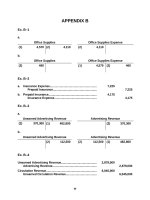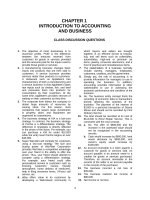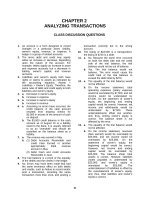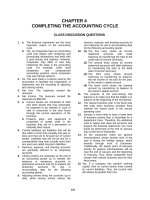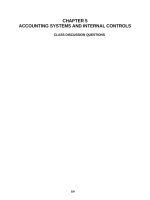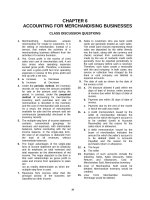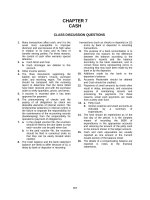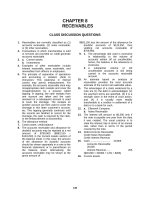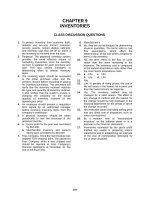Solution manual investments 10th by jones ch20
Bạn đang xem bản rút gọn của tài liệu. Xem và tải ngay bản đầy đủ của tài liệu tại đây (189.46 KB, 17 trang )
Chapter 20:
Capital Market Theory
CHAPTER OVERVIEW
Chapter 20 follows Chapter 19 because capital market theory
builds on portfolio theory by examining how asset prices are
determined in a world of Markowitz diversifiers. Chapter 20 also
contains some important concepts relevant to a better
understanding of such topics as systematic and nonsystematic risk
and beta.
The first part of Chapter 20 outlines the necessary
assumptions to derive capital market theory and introduces the
concept of equilibrium in the capital markets. Important related
concepts are introduced and discussed, primarily the market
portfolio. Both its importance and its composition are
considered.
Using the concepts developed to this point, the equilibrium
risk--return tradeoff is analyzed in detail. The capital market
line is developed and illustrated. This line applies to
efficient portfolios, with the slope of the line showing the
market price of risk for efficient portfolios. The equation is
explained, and certain points about the line are emphasized.
The security market line is developed next. The equation is
developed, and beta as a measure of volatility is considered in
some detail. The CAPM’s expected return--beta relationship is
analyzed, with each of the components of the required rate of
return analyzed and explained. The process of identifying
undervalued and overvalued securities using the SML follows this
discussion.
Problems in estimating the SML are described, and this leads
into a detailed discussion of the accuracy of beta estimates and
tests of the CAPM. The characteristic line is also explained.
The chapter concludes with a complete discussion of
Arbitrage Pricing Theory in terms of what beginners need to know.
Although this concept probably has not advanced in terms of being
widely used in the investments world as much as some have
predicted, it is an important development that can be used for
discussion purposes if the instructor so chooses. Factor models
28
are explained as part of this discussion. A reasonably detailed
discussion on understanding the APT is included. Consistent with
the emphasis in this text, the use of APT in investment decisions
is considered. Students should be able to see how the model
could be applied in actual practice.
NOTE: The discussion of APT probably contains all that
beginners need to know and can reasonably handle.
CHAPTER OBJECTIVES
To develop the concept of asset pricing theory as a natural
extension of portfolio theory.
To develop the concepts of the CML and SML, explain what
they mean, and consider how they can be used.
To discuss related issues such as what beta measures and the
problems with estimating beta, systematic and nonsystematic
risk, problems in testing asset pricing models, and so
forth.
To provide the necessary information about APT, including
what it means and how it could be used to make investment
decisions.
29
MAJOR CHAPTER HEADINGS [Contents]
The Assumptions Of The CAPM
[assumptions used to derive capital market theory]
Equilibrium in the Capital Markets
[What are the implications of the assumptions?]
The Market Portfolio
[definition; graph showing the market portfolio on the
efficient frontier]
The Importance of the Market Portfolio
[Why do all investors hold identical risky portfolios?]
Composition of the Market Portfolio
[what it consists of; limitations]
The Equilibrium Return--Risk Tradeoff
[CAPM is an equilibrium relationship encompassing both the
CML and the SML]
The Capital Market Line
[equation; diagram; example; important points to note about
the CML]
The Security Market Line
[deriving the equation; graph; what beta is; the CAPM's
expected return--beta relationship; over-and-undervalued
securities with explanation and diagram]
Estimating the SML
[estimating the variables in the equation]
Estimating Beta
[the accuracy of beta estimates; characteristic line for
Coca-Cola; problems when estimating beta; stability of
portfolio beta]
Tests Of The CAPM
[predictions of the model; findings]
Arbitrage Pricing Theory
[basic description of the model; assumptions; factor models;
characteristics of factors; example of factor model;
equations for actual return and expected return; factors
that have been identified through research]
Using APT in Investment Decisions
[possible strategies when using APT to make decisions]
Some Conclusions About Asset Pricing
[controversy remains]
POINTS TO NOTE ABOUT CHAPTER 20
Tables and Figures
There are no tables or boxed inserts in Chapter 20.
The four major figures in this chapter are all standard
figures of the efficient frontier with borrowing and lending, the
CML, the SML, and so forth. As such, they are interchangeable
with virtually any other comparable figures that an instructor
may already have developed. They are not unique although they
are keyed to the discussion in the text.
Figure 20-1 shows the Markowitz efficient frontier and the
borrowing and lending possibilities resulting from introducing a
risk-free asset. This figure is the same as Figure 7-5 except
the point of tangency has been changed from T to M to emphasize
the market portfolio and its importance.
Figure 20-2 shows the capital market line and the components
of its slope. It is important to emphasize that standard
deviation is on the horizontal axis and to emphasize what the
slope of this line measures.
Figure 20-3 shows the SML. The emphasis now is on beta as
the measure of risk on the horizontal axis.
Figure 20-4 illustrates how an overvalued and an undervalued
security can be identified by using the SML. It could be pointed
out here that in some sense this is how to think of modern
security analysis--the search for securities not on the
equilibrium tradeoff that should exist.
Figure 20-5 shows the characteristic line for Coca-Cola,
using monthly data.
ANSWERS TO END-OF-CHAPTER QUESTIONS
20-1.
Lending possibilities change part of the Markowitz
efficient frontier from an arc to a straight line. The
straight line extends from RF, the risk-free rate of
return, to M, the market portfolio. This new opportunity
set, which dominates the old Markowitz efficient
frontier, provides investors with various combinations of
the risky asset portfolio M and the riskless asset.
Borrowing possibilities complete the transformation of
the Markowitz efficient frontier into a straight line
extending from RF through M and beyond. Investors can
use borrowed funds to lever their portfolio position
beyond point M, increasing the expected return and risk
beyond that available at point M.
20-2.
Under the CAPM, all investors hold the market portfolio
because it is the optimal risky portfolio. Because it
produces the highest attainable return for any given risk
level, all rational investors will seek to be on the
straight line tangent to the efficient set at the
steepest point, which is the market portfolio.
20-3.
The basic difference between graphs of the SML and the
CML is the label on the horizontal axis. For the CML, it
is standard deviation while for the SML, beta. Also, the
CML is applicable to portfolios while the SML applies to
individual securities and to portfolios.
20-4.
In theory, the market portfolio (portfolio M) is the
portfolio of all risky assets, both financial and real,
in their proper proportions. Such a portfolio would be
completely diversified; however, it is a risky portfolio.
In equilibrium, all risky assets must be in portfolio M
because all investors are assumed to hold the same risky
portfolio. If they do, in equilibrium this portfolio must
be the market portfolio consisting of all risky assets.
20-5.
The slope of the CML is
ERM - RF
────────
SDM
where ERM is the expected return on the market M
portfolio, RF is the rate of return on the risk-free
asset, and SDM is the standard deviation of the returns
on the market portfolio.
The slope of the CML is the market price of risk for
efficient portfolios; that is, it indicates the
equilibrium price of risk in the market. It shows the
additional return that the market demands for each
percentage increase in a portfolio's risk.
20-6.
The CML extends from RF, the risk-free asset, through M,
the market portfolio of all risky securities (weighted by
their respective market values). This portfolio is
efficient, and the CML consists of combinations of this
portfolio and the risk-free asset. All asset
combinations on the CML are efficient portfolios
consisting of M and the risk-free asset.
20-7.
The contribution of each security to the standard
deviation of the market portfolio depends on the size of
its covariance with the market portfolio. Therefore,
investors consider the relevant measure of risk for a
security to be its covariance with the market portfolio.
20-8.
Using some methodology (such as the dividend valuation
model) to estimate the expected returns for securities,
investors can compare these expected returns to the
required returns obtained from the SML. Securities whose
expected returns plot above the SML are undervalued
because they offer more expected return than investors
require; if they plot below the SML, they are overvalued
because they do not offer enough expected return for
their level of risk.
20-9.
When a security is recognized by investors as
undervalued, they will purchase it because it offers more
return than required, given its risk. This demand will
drive up the price of the security as more of it is
purchased. The return will be driven down until it
reaches the level indicated by the SML as appropriate for
its degree of risk.
20-10.
The difficulties involved in estimating a security's beta
include deciding on the number of observations and the
length of the periods to use in calculating the beta.
The regression estimate of beta is only an estimate of
the true beta, and subject to error. Also, the beta is
not perfectly stationary over time.
20-11.
The major problem in testing capital market theory is
that the theory is formulated ex-ante, concerning what is
expected to happen. The only data we typically have are
ex-post.
20-12.
The CAPM can be tested empirically by regressing the
average return on security i over some number of periods
on security I’s beta. This is usually done for a large
number of securities. The equation involved is:
_
Ri = a1 + a2bi
_
where Ri is the average return on security i over some
number of periods and bi is the estimated beta for
security i.
The expected results of regressing average returns on
beta are that a1 should approximate the average risk-free
rate during the period studied and a2 should approximate
the average market risk premium during the period studied
(RM - RF).
20-13.
The law of one price states that two otherwise identical
assets cannot sell at different prices.
20-14.
Roll has argued that the CAPM is untestable because the
market portfolio, which consists of all risky assets, is
unobservable.
20-15.
The CAPM is a useful model for estimating required
returns. These required returns can be used in
conjunction with independently derived expected returns
to determine overvalued and undervalued securities. This
model is also useful in estimating the cost of equity
capital for a security. And, as we shall see in Chapter
22, the CAPM provides a basis for measuring portfolio
performance.
20-16.
The CML is drawn tangent to the Markowitz efficient
frontier. When this is done, it can be seen that the CML
dominates the Markowitz efficient frontier. The CML is a
straight line tangent to the efficient frontier at point
M, the market portfolio, and with an intercept of RF.
20-17.
Investors decide where they are to be on the new
efficient frontier (the straight line dominating the
Markowitz efficient frontier) by their risk preferences.
If they are conservative, they will be on the lower end
of the line toward RF; if aggressive, they will be on the
upper end, which represents larger expected returns and
larger risks.
20-18.
The CML is the trade off between expected returns and
risk for efficient portfolios. The slope of the CML
indicates the equilibrium price of risk in the market.
20-19.
A diagram of the SML is simply an upward-sloping tradeoff
between expected return on the vertical axis and risk as
measured by beta on the horizontal axis. In effect, this
is a diagram of the whole concept of investing, which is,
in fact, best described simply as an upward-sloping
tradeoff between expected return and risk.
20-20.
(a)
If the risk-free rate shifts upward, and nothing
else changes, the diagram would show a new upwardsloping line above the old line, running parallel
with it. The difference between the two vertical
intercepts would reflect the increase in the riskfree rate.
(b)
In this case, the SML would rotate upward to the
left to reflect a greater tradeoff. As investors
become pessimistic, the line becomes steeper
(rotates upward to the left); as they become
optimistic, the line rotates downward to the right,
approaching a horizontal line at the extreme.
Unlike the CAPM, APT does not assume:
1.
2.
3.
4.
a single-period investment horizon
the absence of taxes
borrowing and lending at the rate RF
investors select portfolios on the basis of
expected return and variance
APT, like the CAPM, does assume:
1.
2.
3.
4.
investors have homogeneous beliefs
investors are risk-averse utility maximizers
markets are perfect
returns are generated by a factor model.
20-21.
A factor model is based on the view that there are
underlying risk factors that affect realized and expected
security returns. These risk factors represent broad
economic forces and not company-specific characteristics
and, by definition, they represent the element of
surprise in the risk factor--the difference between the
actual value for the factor and its expected value.
20-22.
The factors must possess three characteristics:
1.
Each risk factor must have a pervasive influence on
stock returns. Firm-specific events are not APT
risk factors.
2.
These risk factors must influence expected return,
which means they must have non-zero prices. This
issue must be determined empirically, by
statistically analyzing stock returns to see which
factors pervasively affect returns.
At the beginning of each period, the risk factors
must be unpredictable to the market as a whole.
3.
20-23.
Most empirical work suggests that three to five factors
influence security returns and are priced in the market.
For example, Roll and Ross identify five systematic
factors:
1.
2.
3.
4.
5.
changes in expected inflation
unanticipated changes in inflation
unanticipated changes in industrial production
unanticipated changes in the default-risk premium
unanticipated changes in the term structure of
interest rates
20-24.
A factor model makes no statement about equilibrium.
20-25.
A portfolio manager could design strategies that would
expose them to one or more types of these risk factors,
or “sterilize” a portfolio such that its exposure to the
unexpected change in the growth rate of profits matched
that of the market as a whole. Taking an active approach,
a portfolio manager who believes that he or she can
forecast a factor realization can build a portfolio that
emphasizes or deemphasizes that factor. In doing this,
the manager would select stocks that have exposures to
the remaining risk factors that are exactly proportional
to the market. If the manager is accurate with the
forecast--and remember that such a manager must forecast
the unexpected component of the risk factor--he or she
can outperform the market for that period.
20-26.
APT is not critically dependent on an underlying market
portfolio as is the CAPM, which predicts than only market
risk influences expected returns. Instead, APT
recognizes that several types of risk may affect security
returns.
20-27.
An arbitrage profit, in the context of the APT, refers to
a situation where a zero investment portfolio can be
constructed that will yield a risk-free profit. If
arbitrage profits arise, a relatively few investors can
act to restore equilibrium.
20-28.
We can evaluate how each security affects the standard
deviation of the market portfolio by evaluating the way
it would change if the proportion invested in a
particular security changes. (In effect, we take the
partial derivative of the standard deviation of the
market portfolio with respect to the proportion of
portfolio funds invested in that particular security.)
The result is that a security’s contribution to the risk
of the market portfolio is given by:
i,M
--M
where i,M = the covariance between stock i and the
market portfolio.
CFA
20-29.
Any three of the following are criticisms of beta as
used in CAPM.
1.
2.
3.
4.
CFA
20-30.
Theory does not measure up to practice. In theory,
a security with a zero beta should give a return
exactly equal to the risk-free rate. But actual
results do not come out that way, implying that
the market values something besides a beta measure
of risk.
Beta is a fickle short-term performer. Some shortterm studies have shown risk and return to be
negatively related. For example, Black, Jensen and
Scholes found that from April 1957 through
December 1965, securities with higher risk
produced lower returns than less risky securities.
This result suggests that (a) in some short
periods, investors may be penalized for taking on
more risk; (b) in the long run, investors are not
rewarded enough for high risk and are
overcompensated for buying securities with less
risk; and (c) in all periods, some unsystematic
risk being valued by the market.
Estimated betas are unstable. Major change in a
company affecting the character of the stock, some
unforeseen event not reflected in past returns may
decisively affect the security’s future returns.
Beta is easily rolled over. Richard Roll has
demonstrated that by changing the market index
against which betas are measured, one can obtain
quite different measures of the risk level of
individual stocks and portfolios. As a result, one
would make different predictions about the
expected returns, and by changing indexes, one
could change the risk-adjusted performance ranking
of a manager.
Under CAPM, the only risk that investors should be
compensated for bearing is the risk that cannot be
diversified away (systematic risk). Because systematic
risk (measured by beta) is equal to one for both
portfolios, an investor would expect the same return for
Portfolio I and II.
Since both portfolios are fully diversified, it doesn't
matter if the specific risk for each individual security
is high or low. The specific risk has been diversified
away for both portfolios.
CFA
20.31.
b
CFA
20.32.
a
CFA
20.33.
d
CFA
20.34.
b
CFA
20.35.
d
CFA
20-36.
The following comments are presented in the same order as
the points made by Statdud:
1.
This statement is incorrect. Since monthly
observations (returns) are employed, the constant
(alpha) value of .59 indicates that if the return
on the S&P 500 were zero in a given month, the
monthly return on the stock would tend to be .59%.
During a year when the return on the S&P 500 is
zero, the annual return on the stock can be
approximated as: (.59%) x (12) = 7.08%.
2.
This statement is incorrect. The alpha value of .
59 is the y-interest and represents a return on CCE
that is unrelated to the return on the market.
Variability of the market is measured by variance
or standard error of the estimate.
3.
The statement regarding the slope coefficient and
the volatility of the return on CCE’s common stock
relative to the market is correct, assuming that
the S&P 500 represents the average stock.
4.
This statement is incorrect. The high t-statistic
for the slope coefficient (beta) suggests the value
is statistically significant at the .01 level.
5.
This statement is incorrect. The R2 of .215
indicates that 21.5% of the dependent variable
(return on CCE common stock) is explained by the
independent variable (return on the market).
6.
This statement is incorrect. The slope term
(beta) is statistically significant in this problem
and alpha is not. Beta values found by regressing
stock returns against market returns tend to be
more stable over time than alpha values.
7.
This statement is incorrect. While rerunning the
regression using data over a longer period should
improve the statistical reliability of the
estimated coefficients, it is not without a price.
The new regression would be constructed using data
that may be so old that it does not reflect the
current situation.
ANSWERS TO END-OF-CHAPTER PROBLEMS
20-1.
Characteristic Line
ß
_
Y
Y
20-2.
20-3.
= 3061.185/3946.285 = .7757131
_
= 11.61
X = 8.45
= 11.61-(.7757131)(8.45) = 5.055224
= 5.055 + 0.776X
(a)
CML slope = (12-8)/20 = .2
(b)
Affiliated
Omega
Ivy
Value Line
New Horizons
(c)
The rank order is the same as in (b), which is
from low risk to high risk.
(d)
Ivy does because it has the same risk as
measured by the standard deviation.
(a)
From the SML:
Stock 1
2
3
4
5
(b)
8
8
8
8
8
8
8
8
8
8
+
+
+
+
+
.2
.2
.2
.2
.2
(14)
(16)
(20)
(25)
(30)
=
=
=
=
=
10.8%
11.2%
12.0%
13.0%
14.0%
+ .9(4) = 11.6%
+ 1.3(4) = 13.2%
+ .5(4) = 10.0%
+ 1.1(4) = 12.4%
+ 1.0(4) = 12.0%
This is the SML, with the formula
Ri = 8 + 4bi
20-4.
(c)
Funds 1, 3, and 4 are undervalued because each
has an expected return greater than its
required return as given by the SML.
(d)
The slope of the SML, or (12-8) = 4.
(a)
In order to calculate the beta for each stock,
it is necessary to calculate each of the
covariances with the market, using the
correlation coefficient for the stock with the
market, the standard
deviation of the stock, and the standard
deviation of the market.
Stock A
cov
= (.8)(25)(20) = 400
beta = 400/(20)2 = 1.0
Stock B
cov
= (.6)(30)(20) = 360
beta = 360/(20)2 = .9
(b)
From the SML, Ri
Stock A
Stock B
= 8 + (12-8)bi
= 8 + (12-8)(1.0) = 12%
= 8 + (12-8)(.9) = 11.6%
20-5.
(a)
ER = (.6)(7) + (.4)(12)
(b)
ER = (-.5)(7) + (1.5)(12) = 14.5%
(c)
ER = (0)(7) + (1.0)(12)
20-6.
SD = .4(20) = 8%
SD = 1.5(20) =
30%
SD = 20%
= 12%
E(Ri) = 7.0 + (13.0-7.0)bi = 7.0 + 6.0bi
GF
PepsiCo
IBM
NCNB
EG&G
EAL
20-7.
= 9%
7
7
7
7
7
7
+
+
+
+
+
+
6( .8)
6( .9)
6(1.0)
6(1.2)
6(1.2)
6(1.5)
=
=
=
=
=
=
11.8%
12.4%
13.0%
14.2%
14.2%
16.0%
<
<
<
>
<
>
12%
13%
14%
11%
20%
10%
undervalued
undervalued
undervalued
overvalued
undervalued
overvalued
If Exxon is in equilibrium, the relationship is:
.14 = RF + [E(RM - RF] ß
= 6 + [E(RM - 6] 1.1
Therefore,
a.
the slope of the SML must be [E(RM - 6] or
approximately 7.3% in order for the
relationship to hold on both sides
b.
the expected return on the market is 7.3% + 6%
or 13.3%
(approximately)
